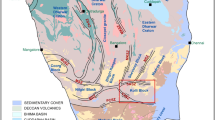Abstract
The study of magnetization of the ceramic material from 21 archeological monuments of Portugal (the Evora province), dated archeologically from the Bronze Age to the end of the Iron Age has been carried out. For the purpose of more detailed timing of the material from the monuments the method of ceramic age dating on the basis of its porosity has been used. In order to take into account the distorted factors in the determination of the parameters of the ancient geomagnetic field with the aim of the maximal approximation to the actual values the diagnostic features of magnetite weathering have been considered and the level of weathering of the magnetic fraction in the ceramics from archeological monuments has been determined. The data of geomagnetic field-strength variation in the time interval of the 12th century BC to the beginning of the Common Era have been obtained. The field-strength at this time interval varied in the range of 60–90 micro Tesla with the maximal values in the 9th, 8th, and the second half of the 5th to the beginning of the 4th century BC. In addition, the timing of the ceramic material from the urns of the megalithic complex Monte de Tera of the Evora province has been clarified.
Similar content being viewed by others
References
V. I. Bagin, T. S. Gendler, and T. K. Avilova, Magnetizm of iron α-oxides and hydroxides (IFZ AN SSSR, Moscow, 1988) [in Russian].
K. S. Burakov, I. E. Nachasova, T. Nájera, et al., “The geomagnetic field-strength in the 2nd millennium BC in Spain,” Fiz. Zemli, (8), 28–40 (2005).
K. S. Burakov, I. E. Nachasova, and K. Mata, “The geomagnetic field-strength in the 1st millennium BC on the results of study of the ceramics of the archeological monument “Los Villares,” Fiz. Zemli, (11), 84–92 (2006).
I. E. Nachasova, “The characteristics of the geomagnetic field-strength on the archeomagnetic data,” in Avtoref. diss. (OIFZ RAN, Moscow, 1988) [in Russian].
I. E. Nachasova, K. S. Burakov, and J. Bernabeu, “Geomagnetic field variation in Spain,” Fiz. Zemli, (5), 24–29 (2002a).
I. E. Nachasova, K. S. Burakov, and J. Bernabeu, “Archeomagnetic studies of pottery from the Neolithic multilayered Cendres Cave monument (Spain),” Geomagn. Aeron. 42(6), 845–851 (2002b).
I. E. Nachasova, K. S. Burakov, and T. A. Il’ina, “The geomagnetic field-strength in the East Mediterranean in the 2nd millennium BC the beginning of the Common Era,” Fiz. Zemli, (12), 48–54 (2007a).
I. E. Nachasova, K. S. Burakov, and A. J. Lorrio, “Archeomagnetic researches of the ceramics from the archeological monument “El Molon”, Spain,” Fiz. Zemli, (10), 35–40 (2007b).
L. Rocha, “O monumento megalitico da I Idade do Ferro do Monte da Tera (Pavia, Mora): Sectores 1 e 2,” Revista Portuguesa de Arqueologia, 6(1), 121–129 (2003).
Author information
Authors and Affiliations
Corresponding author
Additional information
Original Russian Text © I.E. Nachasova, K.S. Burakov, 2009, published in Fizika Zemli, 2009, No. 7, pp. 54–62.
Rights and permissions
About this article
Cite this article
Nachasova, I.E., Burakov, K.S. Variation of the intensity of the Earth’s magnetic field in Portugal in the 1st millennium BC. Izv., Phys. Solid Earth 45, 595–603 (2009). https://doi.org/10.1134/S1069351309070040
Received:
Published:
Issue Date:
DOI: https://doi.org/10.1134/S1069351309070040




